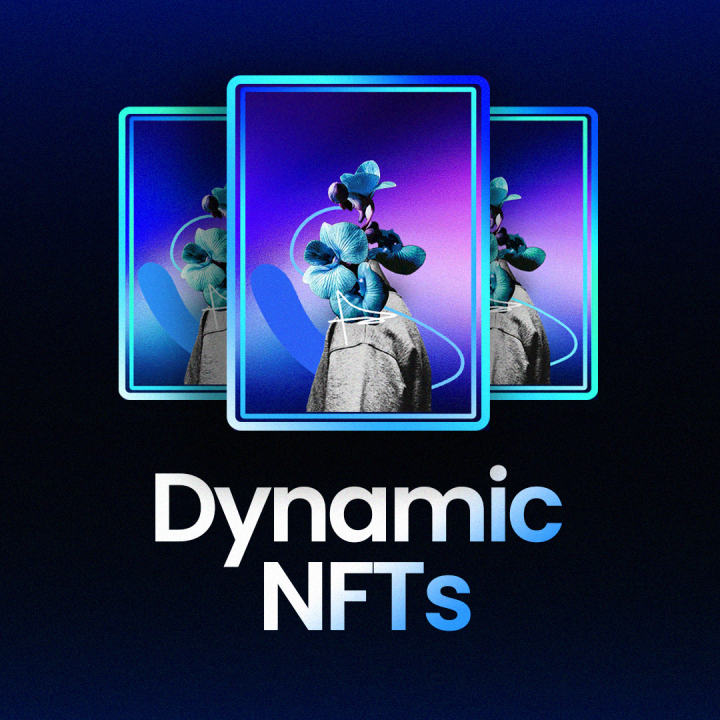
What are Dynamic NFTs (dNFTs)
Dynamic NFTs, or dNFTs, are non-fungible tokens with the unique ability to change their attributes or metadata over time.
Unlike static NFTs, which remain immutable after creation, dNFTs adapt based on external conditions, user interactions, or pre-defined triggers coded into their smart contracts.
Key Takeaways:
- Dynamic NFTs can evolve and change their attributes based on external data or user interactions.
- They enhance functionality, making NFTs more useful in gaming, identity, and real-world applications.
- Smart contracts and oracles power their adaptability, ensuring trustless and automated updates.
Key Features of Dynamic NFTs
Interactivity:
Dynamic NFTs can seamlessly interact with external data sources, enabling them to evolve or adapt in real-time.
For example, a dNFT artwork might change its appearance based on weather data, such as turning rainy on a stormy day or sunny when the skies are clear.
Similarly, user engagement can drive transformations, such as unlocking additional visual layers or features as collectors interact with the NFT.
This interactivity fosters deeper user engagement and adds a layer of personalization.
Programmable Logic:
Built using smart contracts, dNFTs contain pre-defined conditional rules that dictate how and when changes occur.
These rules are executed in an automated and trustless manner, ensuring the integrity of the NFT’s evolution.
For instance, a sports card dNFT might automatically update to reflect an athlete’s latest statistics, or a commemorative dNFT could unlock exclusive content on a significant anniversary.
Enhanced Utility:
Dynamic NFTs go beyond static collectibles by introducing practical functionality across various sectors. In gaming, they enable assets like characters or weapons to evolve as players achieve milestones.
For identity verification, dNFTs provide dynamic updates to credentials, such as expiring certifications or real-time status updates.
Additionally, tokenized real-world assets like property ownership can leverage dNFTs and ERC-1155 standards to display valuation changes, rental income, or maintenance history, making them more versatile and actionable.
Applications:
- Gaming: Characters, items, or assets in blockchain-based games can evolve based on in-game achievements or player interactions. For instance, a sword NFT might upgrade in design and power as the player progresses.
- Digital Art: Dynamic NFTs enable artists to create pieces that evolve based on external factors such as the time of day, user engagement, or specific events (e.g., a holiday-themed transformation).
- Event Tickets: dNFTs can be used as event passes that update after scanning to show the attendee’s access level or post-event perks, such as exclusive content.
- Identity Verification: Dynamic NFTs can represent digital identities, updating attributes like age, status, or credentials in real time while maintaining privacy.
- Real Estate: Tokenized property ownership can reflect real-time updates, such as changes in valuation, rent payments, or ownership status.
Technology Stack:
- Oracles: External data providers (like Chainlink) supply real-world information that triggers changes in dNFT metadata.
- Smart Contracts: Solidity, Vyper, and similar languages enable developers to code the dynamic rules governing the NFTs.
- Decentralized Storage: Platforms like IPFS or Arweave ensure the integrity and accessibility of the NFT’s data as it evolves.
Challenges:
- Complexity: Developing dNFTs requires sophisticated coding and seamless integration with external data sources.
- Gas Costs: Frequent updates to metadata can increase transaction costs on blockchains with high fees, like Ethereum.
- Data Reliability: Dependence on external oracles makes dNFTs susceptible to inaccurate or tampered data if not carefully managed.
- Interoperability: Ensuring compatibility across different platforms and blockchains remains a technical hurdle.
Future Outlook of Dynamic NFTs
Dynamic NFTs represent the next evolution of non-fungible tokens, offering unprecedented interactivity and functionality.
As blockchain scalability improves and more advanced tooling becomes available, dNFTs are poised to reshape industries ranging from entertainment and art to finance and identity verification.
Conclusion
In summary, dynamic NFTs are revolutionizing the blockchain space by offering adaptability and functionality that static NFTs cannot match.
From evolving gaming assets to real-time updates in identity verification, dNFTs open up new opportunities across industries.
As the technology matures, dNFTs are set to redefine digital ownership, making them a cornerstone of Web3 innovation.
Related Terms:
FAQs
- What makes a dynamic NFT different from a static NFT? Dynamic NFTs can change their attributes or metadata based on external factors or user interactions, whereas static NFTs remain immutable after creation.
- What are some practical use cases for dynamic NFTs? Dynamic NFTs can be used in gaming, digital art, event ticketing, identity verification, and tokenized real estate to provide real-time updates and interactive functionality.
- What challenges do dynamic NFTs face? Key challenges include the complexity of development, high gas costs for frequent updates, reliance on external oracles for data, and ensuring interoperability across platforms.




